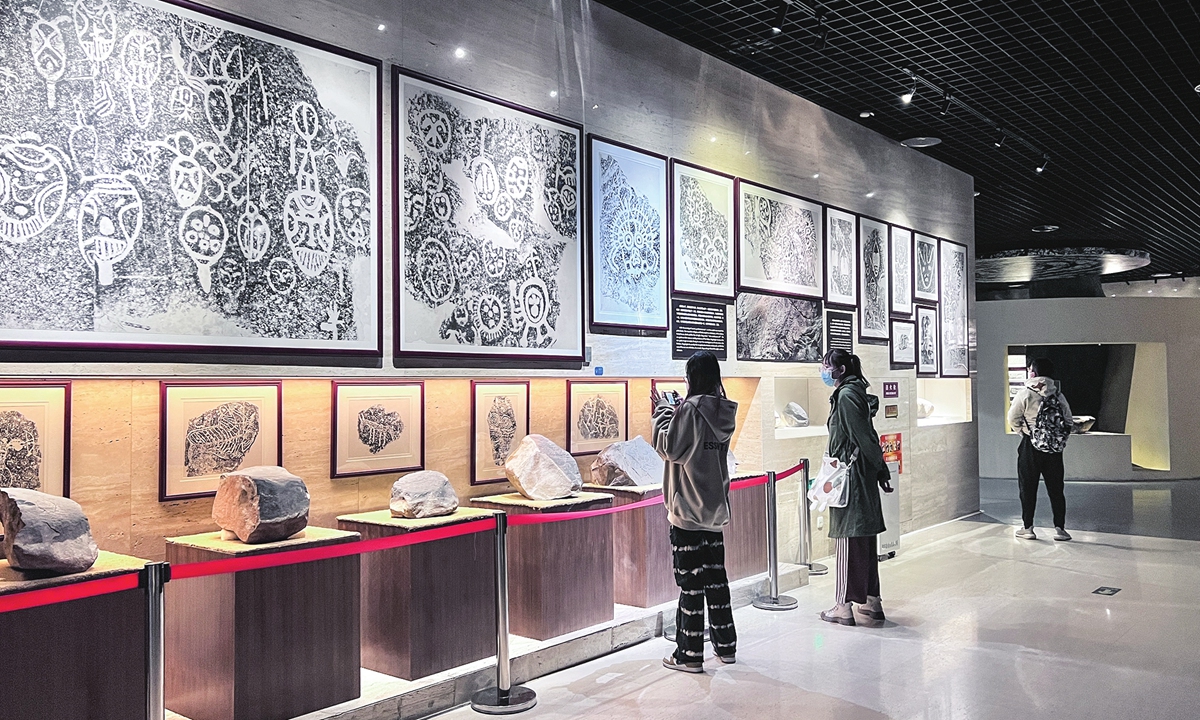ARTS / CULTURE & LEISURE
NW China's Ningxia boosts tourism via unique resources
The interweaving of nature and history

A group of desert hikers walk through the Tengger Desert in Ningxia. Photo: Courtesy of Xiao Kun

Ningxia Museum Photo: Leng Shumei/GT
For years, tourist guide Xiao Kun has led thousands of groups of desert hikers through the Tengger Desert. He said desert isolates him from the hustle and bustle of the city and makes him find peace. He never gets tired of such feeling no matter how many times he walks through the desert.
This is the same feeling people seek when they avoid tourism hotspots during the high season and choose the desert during the May Day holidays instead.
"The desert shows me how insignificant mankind is compared with nature," Liu, a young woman in her twenties, told the others in her hiking group before entering the desert on April 28.
The Tengger Desert, covering an area of about 43,000 square kilometers, is the fourth largest desert in China.
It spans across central Gansu, northern Ningxia and the Southwestern Alxa Left Banner of Inner Mongolia Autonomous Region.
In Mongolian, Tengger means sky. The desert's name then means "as vast as the sky."
Sand dunes, lake basins, mountains and plains interlace in the desert; sand dunes account for more than 70 percent of the surface and crescent-shaped dune chains are usually as high as 10 to 30 meters with some even growing close to 100 meters.
Wild landscape
This tendency agrees with Ningxia's recent efforts to take full advantage of the valuable natural resources to boost local tourism.
Neighboring Inner Mongolia, the semi-arid Ningxia Hui Autonomous Region experiences little rainfall and enjoys around 300 days of clear skies yearly, making it one of the best places to enjoy China's dramatic desert landscapes and engage in some serious stargazing.
One of the best ways to experience Ningxia is by visiting the county of Zhongwei, a place that is very representative of Ningxia's unique advantages in integrating culture and desert resources such as stargazing, the Yellow River and the Silk Road.
For example, the Shapotou scenic spot, 16 kilometers to the west of central Zhongwei, has become a must-see for tourists who visit the province. Shapotou means "the end of the desert" in Chinese.
In fact, Shapotou lies at the junction where the Yellow River meets the Tengger Desert, allowing visitors to enjoy both splendid desert scenery and beautiful riverside views.
Wang Wei, one of the most well-known Chinese poets of the Tang Dynasty (618-907), recorded the beauty of Shapotou in a poem in which he talked about how "In the vast desert rises straight, a lonely smoke blade, the grand, long river reflects the round setting sun."
The scenic spot has a plenty of activities to offer, including drifting on the Yellow River and sliding from the top of a sand dune on a sand board.
Located in the middle of the Shapotou district, the Ningxia's Desert Star Hotel has also become an attraction for lovers of glamping and stargazing.
Walk through past
Besides a wild adventure, visitors can also get a closer look on the long history of China's prosperous exchanges with the outside in Ningxia as the region was also a key stop along the ancient Silk Road.
The region witnessed traders, diplomats, soldiers and adventurers from different countries come and go.
This is where eastern and western civilizations met, collided and fused with each other. It is believed that the minority Muslim Hui community, which makes up 36 percent of its population, descended from Arab merchants who came to China via the historic trade route hundreds of years ago.
It played an important role for the Northern Route of the Eastern Section of the Silk Road and during this period, many merchants, traders, monks and dignitaries passed through Ningxia to reach the Han Region.
As a result, archaeologists have unearthed many cultural relics and artifacts, both foreign and domestic, and traces of the once extremely prosperous exchanges that existed between China and many foreign countries and kingdoms in the West.
The unearthed treasures and remains can now be admired in the Ningxia Museum.
Shaped like a cave, the museum contains an extensive collection of rock carvings and Silk Road artifacts.
The highlights include relics from the imperial tombs of the Western Xia empire, including fascinating representations of the Kalavinka, a mythical Buddhist creature with a human head and a bird's torso that is a common feature in Tangut art and can be observed even on the facade and cornices of the museum's building.
Visitors can also check very interesting petroglyphs dating back to prehistoric times in the museum.
These ancient rock carvings depict and reflect the beliefs, lives and customs of the long-forgotten culture of our ancestors. Every carving in stone was created for the forefathers, as people at the time believed their lives to be dominated by magical powers and other spiritual beliefs that penetrated into every aspect of their daily lives.
This is representative of Ningxia's interweaving nature and history, an aspect of the region that is strongly attracting visitors from all over the country thus boosting the local tourism and economy.


